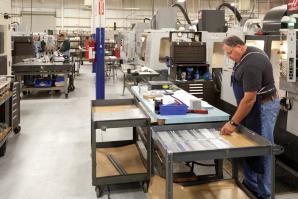Pick up a newspaper’s business section today, and chances are you’ll find more bad news than good. Headlines scream of layoffs, cutbacks and commercial developments with high vacancy rates.
Unless the headlines are about McClellan Park. In a slogging economy, the 3,000-acre business park has managed to not just survive, but thrive.
Since the closure of McClellan Air Force Base in July 2001, McClellan Park took over much of the land and became the single largest industrial facility in Northern California. While the park hasn’t been unscathed by the recession — it’s lost some tenants and jobs — it’s still gained more than it’s lost.
The park has leased 1.6 million square feet over the past five years, says Frank Myers, senior vice president of finance. Almost 75 percent of the available industrial and retail space is occupied, or about 6 million of the available 8 million.
With a total of 230 tenants, about 30 moved into office, storage or manufacturing space during 2010, including Blue Diamond Almonds, L-1 Identity Solutions Inc., Mikuni Japanese Restaurant Group Inc., N Solar Inc. and Aero Union Corp.
They join the park’s other diverse mix of occupants, including Surewest, Northrop Grumman Corp., J.C. Penney Co. Inc., California Family Fitness and Beutler Corp.
At its peak, McClellan Air Force Base was one of the largest employers in Sacramento, employing up to 26,000 people over its 60-year history, and when the closure was announced in 1995, area leaders feared economic disaster for the neighborhood. Indeed, when it closed, 11,600 jobs were lost. But McClellan Park now employs about 15,000.
“We’ve since not only replaced that employment that was lost, but surpassed it,” Myers says.
McClellan also acts as an emergency response base. Besides tenants such as the U.S. Coast Guard, California Department of Forestry and Fire Protection and U.S. Forest Service Wildland Fire Training and Conference Center, California Emergency Management Agency has a 19,500-square-foot space storing emergency supplies and has used McClellan for an emergency response logistics site for more than five years.
Myers says there are many reasons McClellan Park is continuing to attract new tenants. Among them are competitive leases and access to major freeways, rail and airplanes.
“We’ve done well because of the location of the park, the fact that we have buildings that are ready to be occupied and we have a very good marketing team who are doing a great job working with the brokerage community,” he says.
Then there are the enticing amenities such as free Wi-Fi, throngs of security cameras, a hotel, the Aerospace Museum of California, services for active and retired military personnel, a fine-dining restaurant and a park shuttle.
Vacancy rates have stayed lower than most of Sacramento because McClellan is predominately an industrial park. “Industrial has fared a little bit better than office and retail in the marketplace, though it has also taken its share of bumps,” Myers says.
Move-in-ready spaces have given McClellan an edge over some industrial regions, he says. “When you look at West Sacramento, they have standing buildings, certainly, but they also have a lot of raw land that would take some time and expense to construct a new building,” Myers says. “Having existing space allows you to compete at a price point that people will be able to afford.”
Another reason for growth, he says, is heavy investment.
About $580 million has gone into infrastructure and building improvements. This amount reflects more than $208 million from tenants, $280 million from McClellan Park and $88 million in grants from state and federal agencies.
“We’ve had a credit facility in place with Wells Fargo Bank since 2002, and they’ve continued to grow with us. It’s our financing source that covers the tenant improvements and investments we need to make to upgrade facilities,” Myers says. “Just a few months ago we brought US Bank into the facility. They joined Wells Fargo, Bank of America, River City Bank and SAFE Credit Union.”
Those creditors combined have recently loaned a total of $130 million for facility upgrades. Since 2007, those have included: about 20 miles of sewer and three lift stations; several roadway improvements, such as resurfacing all major roadways in 2007-08; realignment of Winters Street with Kilzer Avenue and Dudley Boulevard; upgrading the Peacekeeper Way entrance; parking improvements; and building improvements for approximately 30 tenants in 2010.
McClellan Park couldn’t have done so well over the years without its positive relationships with Sacramento County, the Sacramento Housing and Redevelopment Agency, the U.S. Air Force and the community of North Highlands.
“We have an excellent partnership with Sacramento County that’s very supportive in helping to capture large tenants that otherwise would be going outside the state,” Myers says.
Eventually, McClellan Park will have more retail development, but how much is uncertain, Myers says. “We rezoned a site out on Watt Avenue at our main entrance that someday will accommodate retail,” he says, estimating it could house about 20,000 square feet.
Since breaking ground in October 2009, the project has added a steel superstructure spanning Peacekeeper Way, new signs and landscaping. Several other park sites could work for retail, Myers says, but only if studies show it would be supported.
In August, 560 acres of the business park transferred from the U.S. Air Force to Sacramento County — the largest single property transfer to date at McClellan. This land has some contamination including fuels, polychlorinated biphenyls from old electrical equipment and solvents left over from the former military base.
Under the agreement, the Air Force will fund the cleanup, but McClellan Park will be responsible for conducting most of it, subject to oversight by several government agencies.
“The cleanup structure and process is the first ever of its type,” Myers says. Remaining property must be investigated for toxic substances and cleaned before the rest of the property can change hands.
The one development area that likely won’t be increasing much is housing, Myers says.
This is despite the fact that the park’s 150 residential units, on the east side of the park, are all currently rented, mostly by McClellan employees.
“There are some sites that might work for more residential,” including some old dormitories likely slated for demolition, Myers says. “But I don’t see that increasing significantly.”
McClellan management wants to keep the park’s focus on its core markets, which is mostly industrial and some retail, he says. McClellan Park has the entitlements to construct an additional 6 million square feet of new buildings, creating the potential to employ a work force of 35,000 at full capacity.
To accomplish this goal, McClellan Park officials will “continue to try to do what we’ve done,” Myers says. “We try to ensure the amenities are run in a first-class manner so that people are happy to be here.”
Recommended For You

High Flyin’
How McClellan went from AFB to BP
In 1993 the federal Defense Base Closure and Realignment Commission added McClellan Air Force base to its list of potential closures, and the Capital Region drew in its collective breath.

The Auburn Advantage
How one city turned lifestyle into business leads
Downtown Auburn has a distinct, modern-day Mayberry feel, from the stone-paved sidewalks to the rustic brick bus stop. But five miles away,



